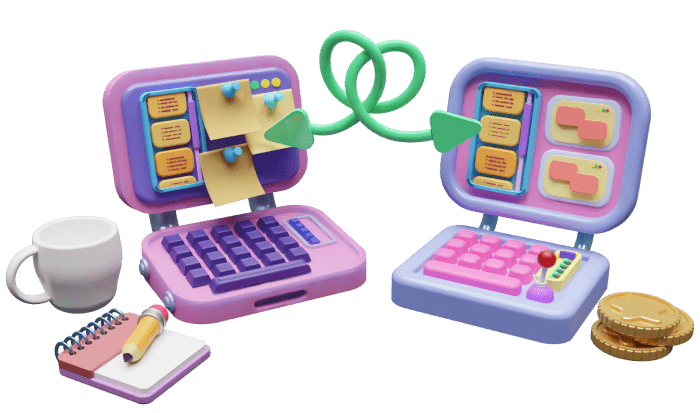
Corporate events are an excellent opportunity for employer branding and engaging with employees or clients.
If you are new to the HR or marketing department and are looking for an ultimate corporate event planning checklist — you are at the right place.
In this article, we will explain corporate event planning and identify the most common types of corporate events.
Moreover, we will provide a list of steps you should take when planning your event and ready-made checklists you can use for small, medium, and large corporate events.
Let’s get started.

Table of Contents
Simply put, a corporate event is an event that a company organizes and funds that focuses on employees or clients.
Regardless of its size, if you want an event to go smoothly, you must plan it carefully, considering all the details and possible pitfalls.
The bigger the event is, the more steps it requires and the more time it consumes.
So, you need to focus your energy on the corporate event planning process — and be clear on your objectives.
Corporate events can vary from internal workshops and team buildings to large-scale conferences.
Here are some reasons for holding corporate events:
Obviously, you need to know what you want to achieve with your event.
For instance, you may want to:
Planning, promoting, and adhering to your budget becomes much easier when you have clearly defined goals and objectives.
Identifying what you want to accomplish will help you:
Your goal formulation should follow the S.M.A.R.T. criteria.
S.M.A.R.T. stands for:
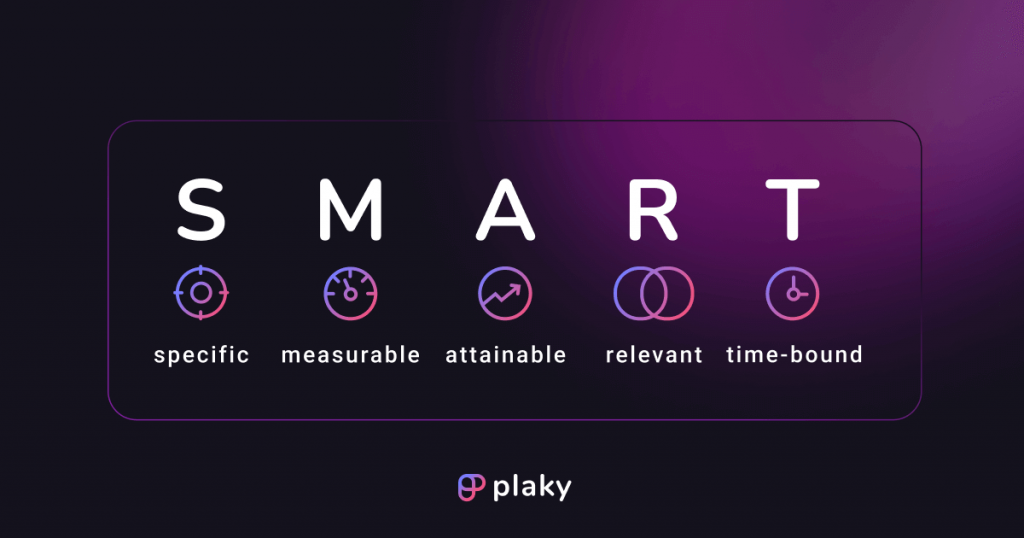
When setting objectives, you should ask yourself the following questions:
Let’s tackle the difference between goals and objectives.
Simply put, objectives are specific actions you take to accomplish a goal.
A goal is a broad, long-term outcome, while an objective is a step you take to get where you want to go.
Goals and objectives work together. If you set goals without precise objectives, you are at risk of not achieving your goals.
For example, a S.M.A.R.T. objective for the goal related to increasing the number of conference participants may be the following:
Increase the number of attendees from outside of California by 15% compared to last year.
💡 Plaky Pro Tip
Read more about S.M.A.R.T. goal setting in our guide:
There is no ultimate list of corporate events that can apply to all businesses.
Depending on your budget and the goal you want to achieve, you may organize some of the following types of events:
Let’s briefly describe what each type entails.
Conferences are large corporate events with an excellent opportunity for business networking.
They usually last a few days, have a central theme, and multiple sessions.
Conferences are commonly held in a conference room, conference hall, or meeting room. They tend to have multiple speakers and sessions across several spaces within one or more venues.
Organizing a conference is an excellent opportunity to raise brand awareness and position your company as an industry expert.
| Event traits | Key takeaways about conferences |
|---|---|
| Size of event: | Large |
| Ideal for: | – Networking Increasing brand awareness – Positioning the company as an industry expert |
As its name suggests, internal training is an internal event.
It is usually a small event intended to improve its participants’ skills.
Internal training can be organized both online and offline.
For instance, your employees may host presentations on the topics from their field of expertise to pass their knowledge on to new team members.
Here are some examples:
| Event traits | Key takeaways about internal training |
|---|---|
| Size of event: | Small |
| Ideal for: | Sharing expertise across departments |
Workshops are educational events for a small group of people that focus on improving techniques and skills in a particular field.
You can organize them internally or hire experts from outside of the company.
For instance, your HR team can organize a workshop on improving resilience.
Moreover, you can organize workshops for an external audience in order to position yourself as an industry leader.
For example, your software development team can hold a one-day workshop for software engineering students in order to attract talent to apply for open positions at your company.
| Event traits | Key takeaways about workshops |
|---|---|
| Size of event: | Small |
| Ideal for: | – Improving techniques and skills in a particular field – Positioning the company as an industry leader |
Seminars are short corporate events with an educational purpose.
They usually last for a few hours or a day and gather professionals to discuss specific business topics and provide opportunities for learning and collaboration.
Unlike conferences, seminars usually have a single speaker or a few speakers.
| Event traits | Key takeaways about seminars |
|---|---|
| Size of event: | Small to medium size |
| Ideal for: | Improving techniques and skills in a particular field |
Trade shows are large corporate events held in big spaces and planned a lot in advance.
They bring a large number of businesses together to showcase, display, and demonstrate their latest products and services.
Companies usually attend trade shows to build brand awareness, promote their business, and generate more leads.
Other advantages of attending trade shows include networking with other professionals and interacting with the media.
Moreover, companies can be sponsors or host trade shows and establish themselves as industry leaders.
| Event traits | Key takeaways about trade shows |
|---|---|
| Size of event: | Large |
| Ideal for: | – Building brand awareness – Business promotion – Lead generation |
A product launch is a type of corporate event most common for business-to-consumer (B2C) companies.
The scale of the event can range from small internal meetings that gather employees to announce upcoming products to large launch parties with external guests and media presence.
The aim of this type of event is to create a buzz around an upcoming product.
| Event traits | Key takeaways about product launches |
|---|---|
| Size of event: | Small to large |
| Ideal for: | – Promoting upcoming products – Business promotion |
Board and stakeholder meetings can range from small internal gatherings to large business events.
The frequency of these types of corporate events depends on:
Board meetings serve board members to review business performance, meet with company executives, and discuss important decisions.
Shareholder meetings are an opportunity for a company to share business performance, future goals, and business strategies with shareholders.
| Event traits | Key takeaways about board meetings and shareholder meetings |
|---|---|
| Size: | Small to large |
| Ideal for: | – Reviewing and sharing business performance – Sharing future goals and business strategies |

Event Planning Template
Simplify the organization and planning of everything event-related — with Plaky’s template.

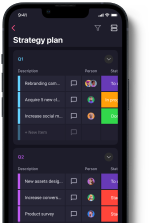
Planning is never easy.
To help you overcome the feeling of overwhelm, we listed eleven steps you can take when planning your corporate events.
Here are a few tips to take care of before organizing a corporate event:
First, you must identify what you want to accomplish with your event.
To determine it seamlessly, you can ask yourself the following questions:
The goal is to organize a meaningful corporate event that resonates with your audience.
Therefore, you should keep your audience’s expectations and needs in mind and organize your event in a manner that will meet these needs.
Knowing what you want to achieve will help you prepare every detail and run an event smoothly — whether it is a conference, a team building event, or a shareholder meeting.
Figuring out your target audience is a critical step to a successful event.
To take it, you should get answers to the following questions:
Defining your attendees’ persona profile also comes in handy.
The attendee persona is a fictional character that represents your attendees.
Using attendee personas can help you understand what motivates people to visit your event and provide valuable insight into what they want to experience.
Some typical characteristics used in event marketing include:
When planning corporate events, you may also think of:
Moreover, a persona should include preferences and needs for events and the most frequent sources of information and influence.
Setting the date and time is one of the most important steps in planning an event.
For example, if you hold a conference, make sure tickets are available at least six months before the event.
Or, you can set the date a few weeks prior for smaller events, like company parties and workshops.
Unlimited space is rarely an option. Knowing the number of guests is critical for managing expenses and preparing all aspects of an event.
Therefore, creating an accurate guest list is a step you do not want to miss.
How to ensure the guest list is accurate?
For instance, if you’re organizing a company birthday party, you must know the number of employees who will attend and how many external guests will participate in the celebration.
You need this information to prepare promotional material, food, drinks, or anything else the guests may need.
To do so, you should send invitations via email and specify the latest date for attendance confirmation.
Suppose your event also involves the sale of tickets. In that case, you should determine the number of available tickets and the latest purchase date.
Whether you organize a small internal gathering or a large conference, you must identify expenses and set a realistic budget.
It will help you allocate resources for planned activities and prevent going over the budget you have at your disposal.
Simply put, you must know how much money you have to work with to determine the type and scale of your event.
To set a proper budget, you may go back to similar past events and gather information on how much money you spent on them.
You should consider all potential expenses, such as:
💡 Plaky Pro Tip
To set your budget seamlessly, check our guide:
As events are experiences, theme and format play a significant role in creating a memorable experience for the audience.
Therefore, you should choose the most suitable format for presenting your intended message.
For instance, if you organize a large IT conference, an interactive presentation and the use of the latest technology solutions are always desirable.
Organizing an event with industry experts and your CTOs as speakers can help your company raise brand awareness. Think of what may be entertaining for your audience and how to make the conference more interactive. No one wants to only sit and listen to long lectures.
The key to a successful event lies in determining what can distinguish your event from similar ones in your industry and make your event unforgettable.
Pick a venue according to the type and size of your event. You should also answer the following questions:
So, list all the potential event venues, contact and visit them, and book the one that suits your needs the best.
After choosing the venue, you should plan the logistics. Here is what you should pay attention on:
Make sure to communicate responsibilities and requirements clearly, so everyone on your team knows what is expected from them.
For smaller, internal events, such as workshops or an office Halloween party, it is usually just fine to send invitations via email and request an attendance confirmation.
Another option can be to inform your employees by posting on a #general team chat app channel and asking them to answer in a thread if they’ll come.
When it comes to larger events, such as conferences or trade shows, you cannot just send out invitations and wait for registrations. You must create a buzz around the event.
For this purpose, you can:
Using a centralized platform to manage all actions needed to prepare a corporate event can save you time and mitigate the possibility of forgetting something critical.
One such centralized platform you can use is Plaky, a free project management tool available for an unlimited number of users and projects.
You can personalize your boards by adding all the details you need for planning an event.
What’s more — you don’t have to start from scratch.
Plaky offers a free event planning template for event managers who want to simplify event organization, planning, and tracking.
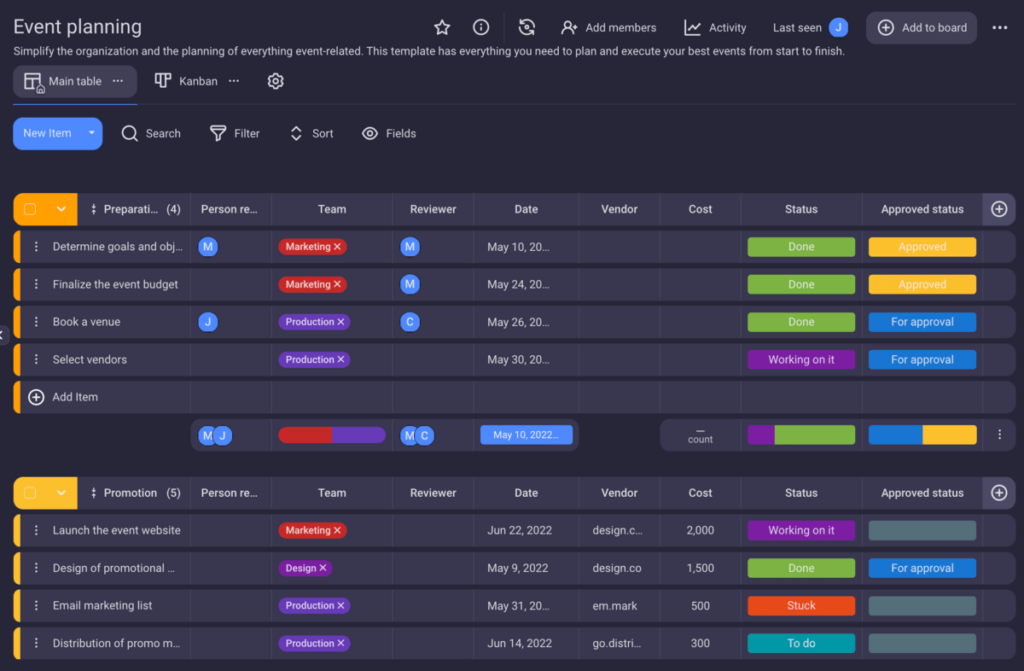
The template contains:
You can easily track progress by using the status field.
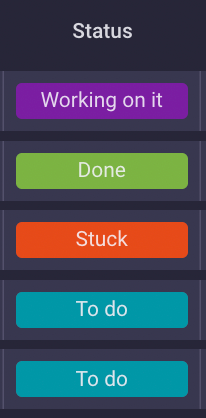
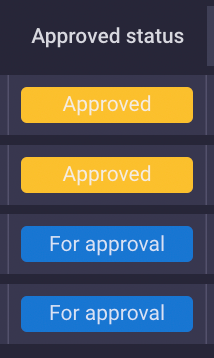
Moreover, by using this template, you can view all vendors at a glance.
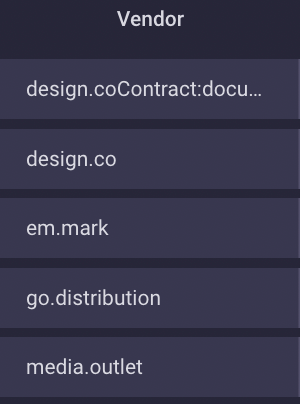
You can also add tags to specify which departments work on particular parts of the organization process.
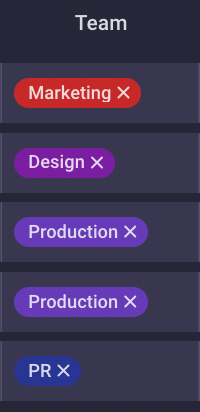
As you can see — you can adjust this template and make it suitable for any type of event you organize.

Event Planning Template
Simplify the organization and planning of everything event-related — with Plaky’s template.


After the event, send follow-up emails to thank all guests and participants.
To check their satisfaction, ask them to fill out an anonymous survey. The feedback you get from such a survey will help you improve upcoming events.
Finally, it’s time to start planning a corporate event of your choice. To save you time, we have prepared free checklist templates you can download and use whenever you need them.
Depending on the event’s size, you can choose from one of the following:
Small corporate events usually have up to 50 attendees.
Let’s take a look at a checklist incorporating the steps you should take to organize them:
| Small corporate event checklist | Status |
|---|---|
| Step 1: Choose the event type | ✅ |
| Step 2: Set goals and objectives | ✅ |
| Step 3: Determine the target attendance | ✅ |
| Step 4: Set the date | ✅ |
| Step 5: Choose the location | ✅ |
| Step 6: Estimate costs | ✅ |
| Step 7: Set the budget | ✅ |
| Step 8: Book the venue (if needed) | ✅ |
| Step 9: Plan the event theme and format | ✅ |
| Step 10: Secure speakers or lecturers | ✅ |
| Step 11: Prepare promotional material | ✅ |
| Step 12: Organize decorations | ✅ |
| Step 13: Choose the catering service | ✅ |
| Step 14: Send invitations and ask for confirmation of attendance | ✅ |
| Step 15: Promote the event on your website and on social media (if it is not an internal event with your employees only) | ✅ |
| Step 16: Double-check the audio and video equipment and wifi connection at the event’s location | ✅ |
| Step 17: Send follow-up emails to attendees and ask for their feedback | ✅ |
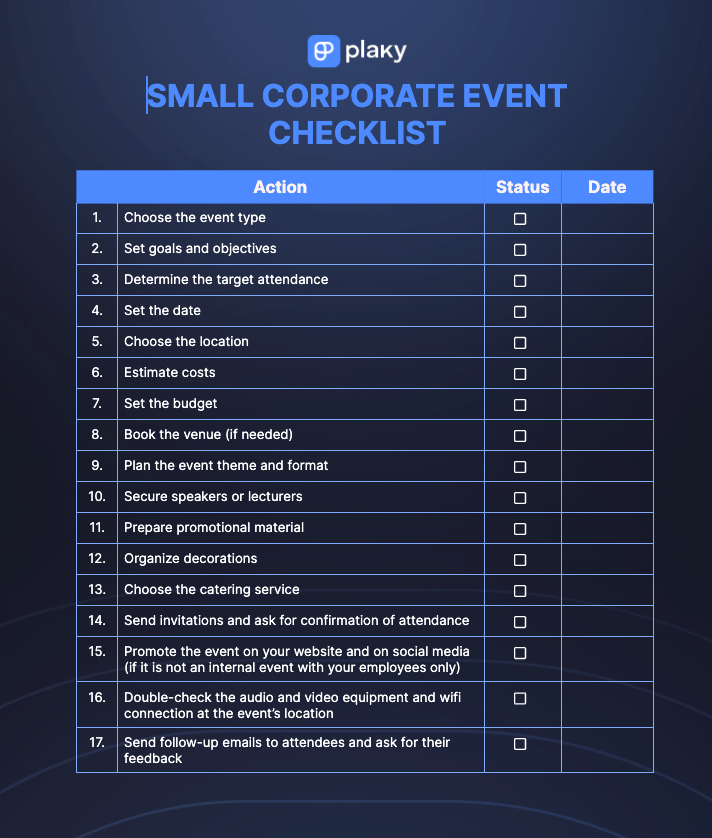
Medium-size corporate events usually have somewhere between 51 and 200 attendees, while large corporate events exceed the number of 200 people.
Let’s see what you need to ensure they go smoothly:
| Medium and large corporate events checklist | Status |
|---|---|
| Step 1: Choose the event type | ✅ |
| Step 2: Set goals and objectives | ✅ |
| Step 3: Determine the target attendance | ✅ |
| Step 4: Set the date | ✅ |
| Step 5: Choose the venue | ✅ |
| Step 6: Check the parking availability | ✅ |
| Step 7: Check if the venue provides food and beverage or if you need to hire external catering | ✅ |
| Step 8: Book external catering, if necessary | ✅ |
| Step 9: Plan the event’s theme and format | ✅ |
| Step 10: Estimate expenses | ✅ |
| Step 11: Set the budget | ✅ |
| Step 12: Reach out to potential speakers | ✅ |
| Step 13: Recruit staff | ✅ |
| Step 14: Finalize and sign contracts with speakers | ✅ |
| Step 15: Prepare a draft of the event schedule | ✅ |
| Step 16: Reach out to sponsors and confirm their sponsorship | ✅ |
| Step 17: Plan menus for meals and refreshments | ✅ |
| Step 18: Arrange transportation and hotel accommodation for guest speakers | ✅ |
| Step 19: Finalize the event schedule | ✅ |
| Step 20: Gather your speaker bios, headshots, and anything else needed | ✅ |
| Step 21: Create an event page or a dedicated website | ✅ |
| Step 22: Set up online registration and ticketing | ✅ |
| Step 23: Gather logos from your sponsors | ✅ |
| Step 24: Make a promo video | ✅ |
| Step 25: Prepare promotional material | ✅ |
| Step 26: Reach out to media outlets to promote the event | ✅ |
| Step 27: Promote your event on social media | ✅ |
| Step 28: Confirm the final number of participants | ✅ |
| Step 29: Finalize seating plan and accreditations | ✅ |
| Step 30: Double-check speaker content | ✅ |
| Step 31: Provide the final number of participants to your staff and caterer | ✅ |
| Step 32: Invite the media to your event | ✅ |
| Step 33: Test equipment to ensure everything works as expected | ✅ |
| Step 34: Send thank-you emails and post-event surveys to speakers and attendees. | ✅ |
You don’t have to create a new checklist — once again, we have an editable template for you.
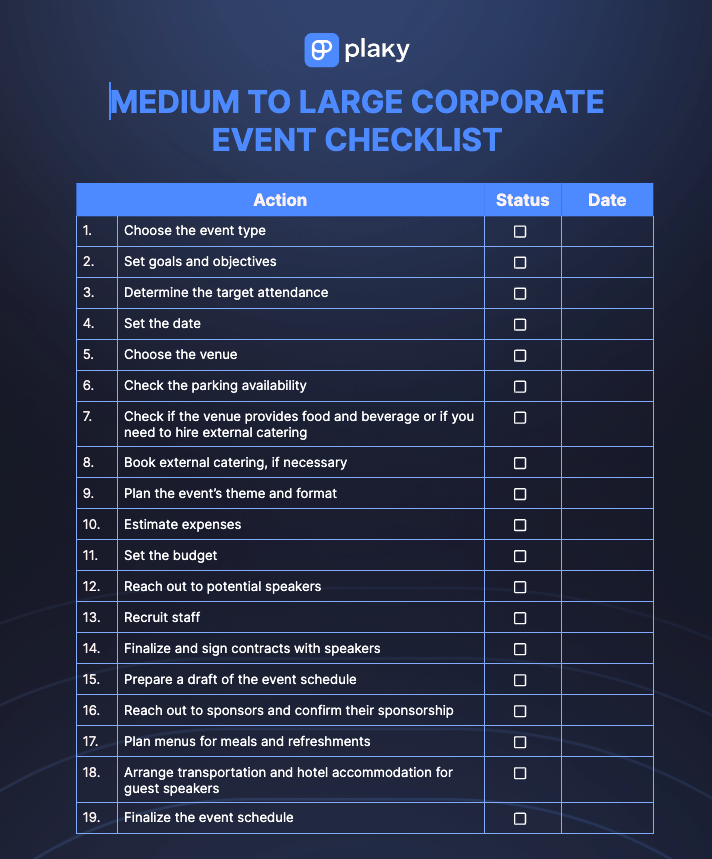
Ready-made templates come in handy to organize your tasks.
However, we recommend using project management software, as you can easily share your board with all relevant people and keep sponsors informed about every change without the need to send them emails.
Organizing an event is always a challenge. There are many details to consider, and it takes a lot of time and preparation.
However, it does not have to be a type of experience you want to pass on to someone else.
To make the process of organizing a corporate event as smooth as it could be, use one of the free corporate event planning checklists we provided, or opt for project management software and enjoy having all the information you need in one place.

Event Planning Template
Simplify the organization and planning of everything event-related — with Plaky’s template.



Vesna Rabuzin Zlokolica
Vesna Rabuzin Zlokolica is a project management author and researcher who always strives to discover new ways to grow personally and professionally. She has a BA in Journalism and an MA in Management. Throughout her career, she has collaborated with project managers, mostly on IT-related projects. Nowadays, she’s focused on making project management easy to understand for all.